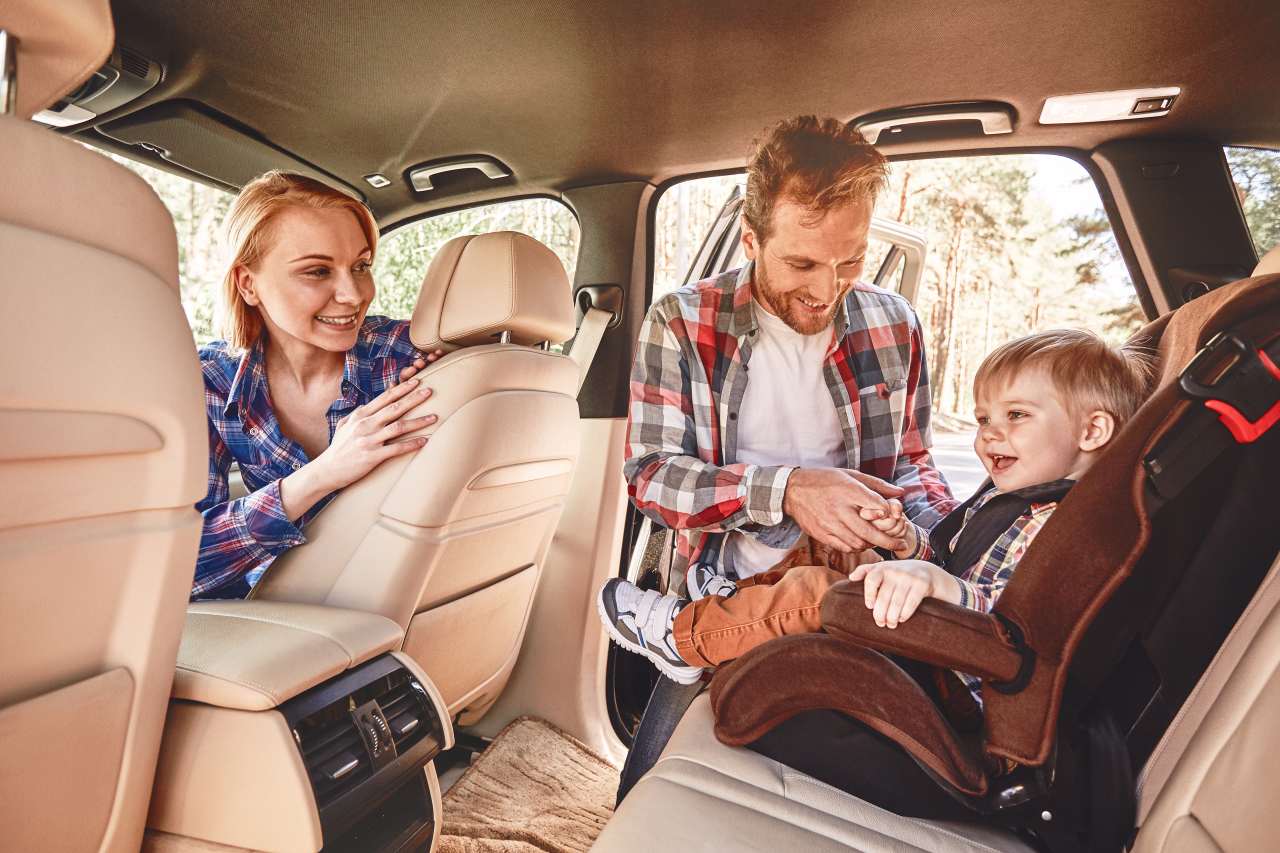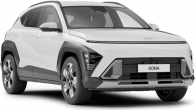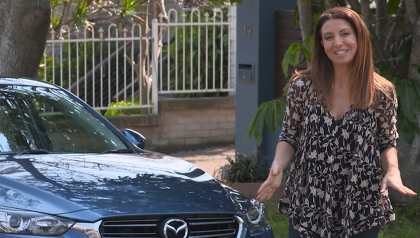Looking at this car you’d be forgiven for thinking it was particularly fun to drive. And you’d be right. It conjures up words I’d never normally think about using, like ‘snazzy’ and ‘funky’ and ‘hip’. But they really encapsulate the feeling you get in a Hyundai Kona. It’s the cool looking small SUV that goes up against cars like the Mazda CX-3, the Honda HR-V and the Toyota C-HR.
Small SUVs are exactly that - quite compact - so when you have growing children you might think they’re not for you. But if you have one child, or small children, is this actually the perfect size? I was in the base model, the Kona Go, with added 'Safety Kit', in the petrol two-wheel drive (2WD) version and I tested it for seven days to find out whether it worked with a real family.
Hyundai Kona 2018: GO Safety (fwd)
| Engine Type | Inline 4, 2.0L |
|---|---|
| Fuel Type | Unleaded Petrol |
| Fuel Efficiency | 7.2L/100km (combined) |
| Seating | 5 |
| Price From | $14,740 - $19,360 |
| Safety Rating |
|
What does it look like?
The Kona is big on exterior looks. It really announces itself when you see it. If it had a voice it’d be saying, ‘Hi, I’m here, and aren’t I fabulous? Don’t you want to jump inside?’
And truth be told it is very inviting. It also comes in a bunch of colours which, depending on your choice, makes a big difference to the way it looks. The sleek headlights and large grille make the front look very modern and it reminds me of one of those all-terrain vehicles we might be driving on planet Mars one day. So it’s a winner in the style stakes.
Inside is not as (here comes that word again) funky, though that's because this is the base model - as is usually the way, the higher the pay grade the more design features you get. But in the Kona Go, there is not much to call out. Everything is fairly stock standard with matte finishes.
One constant however, is that nothing looks cheap, even if we are in the base model. There are fabric seats that look and feel good. The dash and doors don’t look too hard or plasticky which are usually giveaways of a budget finish. Everything inside, while basic and without much flair, is still designed well and you feel good while driving it.
.jpg)
How does it drive?
It’s a really fun car to drive. It zips all over town with all the speed that you need on the school run, on highways, and doing the all the after-school sport. There’s a 2.0-litre engine in the Go I’m driving and it gets up hills swiftly and generally drives with very little effort. I also like the nimble feel of the drive, you can duck in and out of traffic if you need to.
.jpg)
I had the 2WD version, but it does also come in all-wheel drive (AWD) which gives you more traction on the roads in the rain, and will make a difference if you drive on dirt or gravel roads, or if you often take your car to the snow.
Given the size, it parks really easily and has a small turning circle so you can do more u-turns than three-point turns which really makes a difference on the school run. There’s a clear reverse parking camera and rear collision warnings to let you know when you get close to something.
How spacious is it?
When I turned to look at my husband in the driver’s seat over the weekend, he did look as though he was about to touch the roof. He’s 185cm and had about four to five cm of clear space above his head. His legs were definitely bent more than normal but there was still enough leg space. So he fit, all long-legs and bent arms, but it wasn’t what I’d call roomy for him. Of course, at 161cm, I was fine.
.jpg)
My two children aged five and seven had plenty of room for themselves in the back, with enough space in between them not to cause that oh-so-fun bickering. You wouldn’t fit a third child seat in the middle. I have fit three booster seats across, but you’ll get so sweaty trying to do the seatbelts up for such a long while that you wouldn’t want to do it every day.
At 361 litres, boot space is fairly average for this category and though it definitely beats the CX-3’s, it’s smaller than the HR-V’s. It will just fit a pram but not much else can go in, so if you’re still at pram stage you may struggle if you need to bring other stuff with you. I also had to take the boot cover off to fit the pram in.
.jpg)
How easy is it to use every day?
The kids were easily able to climb in and do their own seat belts up - something which may sound basic but various cars do have their seat belt quirks and it can get frustrating if you’re doing them up a few times a day and they’ve disappeared under the back seat.
There are two cupholders in the front and a small centre storage bin, plus a small storage spot to throw keys and a phone. The back centre armrest also houses two cupholders and you’ll get a bottle holder in each door.
There are no air vents in the back, but the front’s air conditioning blasts through to keep rear passengers cool. I drove the Kona on a 37 degree day and the only problem was that I wanted to point the vents at the kids in the back, so didn’t get much of the cool air. Still, I was comfortable once the car had cooled down.
There’s no push start button in this base model, or electric park brake, but sometimes I find an old-school key and pull-up park brake comforting.
What’s the tech like?
The speakers are great. I had to go on a few long drives this week and was able to turn the music up the whole way without fear of the sound distorting.
Standard across the range is Apple CarPlay and Android Auto, simply plug in your phone and it will instantly sync with the 7.0-inch multimedia screen, and the CarPlay worked properly, which it doesn’t always, and also let me bring up Google Maps rather than Apple Maps, hurrah. You can use voice control to make calls or send text messages so you never have to touch your phone while driving. It’s the best technology available at this price point.
.jpg)
How safe is it?
The Hyundai Kona rated a maximum five stars when it was assessed by ANCAP late last year. The Go comes with airbags for driver and front passenger and side curtain airbags that extend to the back row. You’ll also get all the usual safety technology like ABS, Hill Start Assist, traction control, and two ISOFIX points plus three top tether points for children’s car seats.
My car had the Safety Pack installed so for an extra $1500 you’ll get the latest in safety tech including blind spot monitoring, lane departure alerts, auto emergency braking and rear cross traffic alerts.
What does it cost to own?
The Hyundai Kona Go comes in at $23,500, before on-road costs (registration, CTP, stamp duty and dealer delivery charges) with the Safety Kit costing an extra $1500. Fuel consumption is a claimed 7.2L/100km on the combined cycle, however my CarsGuide colleagues tested it and got 10.4L/100km which is fairly similar to the other cars tested in this category.
It’s covered by Hyundai’s five year/unlimited km warranty and free roadside assist if you service it with Hyundai. Services are required every 12 months and the average cost per service over five years is $279.
Verdict
The Hyundai Kona was such a fun car, I enjoyed driving it all week. It zips around town so easily I barely had to think while driving it. It has just enough interior space for the four of us, even if my tall husband did look rather large in it, we were actually quite comfortable. The only space it’s lacking is boot space - if it had a larger boot it would be an excellent family car.
As it stands, I gave it a family rating of seven out of 10, taking points off for the smaller boot, but I did love the way it looked and felt to drive. My kids gave it a 7.5 out of 10, they were won over by the colour.
Pricing Guides



.jpg)
.jpg)
.jpg)
.jpg)










.png)












.jpg)

